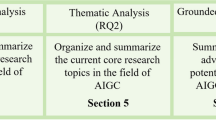Abstract
NIE (newspaper in education), which is the study utilizing newspaper-based educational resources in the classroom, has been pursued for a long time. Traditional NIE allows only one-way interaction and available media are limited. In addition, it has difficulty in capturing the latest “hot” issues or recognizing public opinions. In this paper, we propose a platform called TNIE (Twitter news in education) that utilizes Twitter in NIE. TNIE has many advantages compared to traditional NIE: (1) it classifies the latest news into various topics, (2) the classified news content can be browsed effectively via a hierarchical visualization scheme, and (3) effective discussion or debate groups can be easily formed based on the learners’ news selection. To evaluate the performance of our scheme, we implemented a prototype system and performed several experiments. According to the results, our news classification scheme achieved an 87.8 % F-measure on average, which is superior to the 78.94 % of previous studies. We also had volunteers use our prototype system and evaluate its main functions, e.g., news visualization, classification, learner clustering, and collaborative learning. We report some of these evaluation results.






Similar content being viewed by others
References
Wu Y, Yang J (2013) Developing a multilingual news reading environment for newspaper reading education. In: Proceedings of 2013 IEEE 13th International Conference on Advanced Learning Technologies, IEEE, pp 199–203
Choo H (2005) Online newspaper in education (NIE): a new Web-based NIE model for teaching and learning in school. Dissertation, University of Southern California
Abbott J (2005) NIE: Getting started. A guide for newspaper in education programs. Newspaper Association of America. http://www.americanpressinstitute.org/wp-content/uploads/2013/09/NIE-Getting-Started.pdf. Accessed 9 April 2016
Abbott J, Hendricks M, Vassilikos M et al (2007) Digital NIE. Newspaper Association of America. http://www.americanpressinstitute.org/wp-content/uploads/2013/09/Digital-NIE-A-Guide-to-Using-E-Editions-with-NIE-Programs.pdf. Accessed 9 April 2016
Oliveras B, Márquez C, Sanmartí N (2013) The use of newspaper articles as a tool to develop critical thinking in science classes. Int J Sci Educ 35(6):885–905
Goroshko O, Samoilenko S (2011) Twitter as a conversation through e-learning context. Rev Inf Soc 15:7–25
Carpenter JP, Krutka DG (2014) How and why educators use Twitter: a survey of the field. J Res Technol Educ 46(4):414–434
McLaughlin JE, Roth MT, Glatt DM et al (2014) The flipped classroom: a course redesign to foster learning and engagement in a health professions school. Acad Med 89(2):236–243
Dillenbourg P, Järvelä S, Fischer F (2009) The evolution of research on computer-supported collaborative learning. In: Balacheff N, Ludvigsen S, de Jong T, Lazonder A, Barnes S (eds) Technology-enhanced learning: principles and products. Springer, Netherlands, pp 3–19
Smith BL, MacGregor JT (1992) What is collaborative learning? In: Collaborative learning: a sourcebook for higher education, National Center on Postsecondary Teaching, Learning, and Assessment, University of Pennsylvania State, pp 233–267
Popescu E (2014) Providing collaborative learning support with social media in an integrated environment. World Wide Web 17(2):199–212
Lau R, Yen N, Li F et al (2013) Recent development in multimedia e-learning technologies. World Wide Web 17(2):189–198
Tsai W, Li W, Elston J et al (2011) Collaborative learning using wiki web sites for computer science undergraduate education: a case study. IEEE Trans Educ 54(1):114–124
Zhou W, Simpson E, Domizi D (2012) Google Docs in an out-of-class collaborative writing activity. Int J Teach Learn High Educ 24(3):359–375
Twitter. https://twitter.com/. Accessed 9 April 2016
Holcomb J, Gottfried J, Mitchell A (2013) News use across social media platforms. Pew Research Center. http://www.journalism.org/2013/11/14/News-use-across-social-media-platforms. Accessed 9 April 2016
Dilrukshi I, De Zoysa K, Caldera A (2013) Twitter news classification using SVM. In: Proceedings of 2013 8th International Conference on Computer Science and Education (ICCSE), IEEE, pp 287–291
Bishop JL, Verleger MA (2013) The flipped classroom: a survey of the research. In: Proceedings of 120th American Society of Engineering Education Annual Conference and Exposition
Joachims T (1998) Text categorization with support vector machines: learning with many relevant features. Springer, Berlin Heidelberg
de Cos Juez FJ, Nieto PG et al (2010) Analysis of lead times of metallic components in the aerospace industry through a supported vector machine model. Math Comput Model 52(7):1177–1184
Platt J (1998) Sequential minimal optimization: a fast algorithm for training support vector machines. Technical Report, Microsoft research
Pavlopoulos GA, Soldatos TG, Barbosa-Silva A et al (2010) A reference guide for tree analysis and visualization. BioData Min 3(1):1
Halvey MJ, Keane MT (2007) An assessment of tag presentation techniques. In: Proceedings of the 16th international conference on World Wide Web, ACM, pp 1313–1314
Saha RK, Lease M, Khurshid S et al (2013) Improving bug localization using structured information retrieval. In: Proceedings of 2013 IEEE/ACM 28th International Conference on Automated Software Engineering (ASE), IEEE, pp 345–355
Tsai C, Lee T, Ho I et al (2005) Multi-class clustering and prediction in the analysis of microarray data. Math Biosci 193(1):79–100
Weka 3: Data Mining Software in Java. http://www.cs.waikato.ac.nz/ml/weka/. Accessed 9 April 2016
Lee K, Palsetia D, Narayanan R et al (2011) Twitter trending topic classification. In: Proceedings of 2011 IEEE 11th International Conference on Data Mining Workshops, IEEE, pp 251–258
Uyyanonvara B (2013) Classification of Twitter news. University of Thammasat
Huang P (2009) Surface motion graphs for 3D video-based animation of people. Dissertation, University of Surrey
Kim Y, Na B, Park J, Hwang, E, Rho S (2016) Twitter news in education platform for collaborative learning. In: Proceedings of 2016 International Conference on Platform Technology and Service (PlatCon). IEEE, Jeju, pp 1–4
Acknowledgments
This work was supported by Institute for Information & communications Technology Promotion (IITP) grant funded by the Korea government (MSIP) (No. 2.150379.01, High Performance Big Data Analytics Platform Performance Acceleration Technologies Development).
Author information
Authors and Affiliations
Corresponding author
Additional information
This paper is an extended version of our conference paper [30].
Rights and permissions
About this article
Cite this article
Kim, Y., Hwang, E. & Rho, S. Twitter news-in-education platform for social, collaborative, and flipped learning. J Supercomput 74, 3564–3582 (2018). https://doi.org/10.1007/s11227-016-1776-x
Published:
Issue Date:
DOI: https://doi.org/10.1007/s11227-016-1776-x




